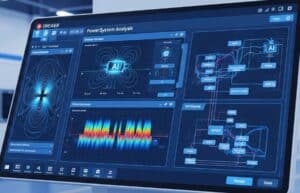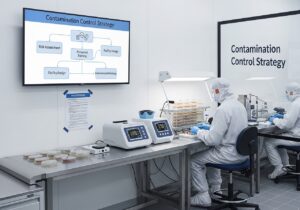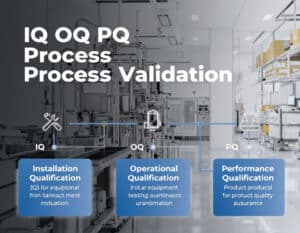
Gli strumenti di intelligenza artificiale online stanno rapidamente trasformando l'ingegneria elettrica, aumentando le capacità umane nella progettazione di circuiti, nell'analisi di sistemi, nell'elettronica e nell'ingegneria di base. produzione, and power system maintenance. These AI systems can process vast amounts of simulation data, sensor readings, and network traffic, identify complex anomalies or performance bottlenecks, and generate novel circuit topologies or control algorithms much faster than traditional methods. For instance, AI can assist you in optimizing PCB layouts for signal integrity and manufacturability, accelerate complex electromagnetic or power flow simulations, predict semiconductor device characteristics, and automate a wide range of elaborazione del segnale e di analisi dei dati.
I suggerimenti forniti di seguito aiuteranno, ad esempio, a progettare in modo generativo antenne o filtri, ad accelerare le simulazioni (SPICE, simulazioni di campi elettromagnetici, analisi della stabilità dei sistemi di alimentazione), a contribuire alla manutenzione predittiva, in cui l'intelligenza artificiale analizza i dati dei sensori dei trasformatori di potenza o dei componenti della rete per prevedere potenziali guasti, consentendo un'assistenza proattiva e riducendo al minimo i tempi di inattività, a selezionare i materiali dei semiconduttori o a scegliere i componenti ottimali (ad esempio, a scegliere il miglior amplificatore operazionale per parametri specifici) e molto altro ancora.
- Questa pagina è specifica per un dominio. Se necessario, è possibile disporre di funzionalità di ricerca complete per tutti i domini e tutti i criteri nel nostro > Elenco dei suggerimenti AI <, dedicato a progettazione del prodotto E innovazione.
- Per motivi di tempo e di risorse del server, le richieste sono riservate ai soli membri registrati e non sono visibili in basso se non si è registrati. È possibile registrarsi, 100% gratuitamente:
È necessaria l'iscrizione
Per accedere a questo contenuto è necessario essere membri.
- Analisi della causa principale
- Ingegneria elettrica
Prompt AI per Analisi dei 5 perché del guasto SCADA
- 5 Perché, Miglioramento continuo, Analisi dei guasti, Tecniche di risoluzione dei problemi, Miglioramento dei processi, Controllo di qualità, Gestione della qualità, Gestione del rischio, Analisi della causa principale
Formula un'analisi dei "5 perché" per individuare la causa principale di un guasto di comunicazione in un sistema SCADA. Questa interrogazione strutturata aiuta a scoprire problemi sistemici più profondi, al di là dei sintomi iniziali.
Uscita:
- Markdown
- non richiede Internet in diretta
- Campi: {problem_statement_SCADA_failure} {sintomo_iniziale_osservato}
You are an AI assistant specialized in industrial control systems and Root Cause Analysis for Electrical Engineers.
**Objective:** Formulate a structured '5 Whys' analysis to investigate the potential root cause of a communication failure in a SCADA (Supervisory Control and Data Acquisition) system.
**Problem Definition:**
- Problem Statement: `{problem_statement_SCADA_failure}` (A concise statement of the overall problem e.g. 'Loss of data from Remote Terminal Unit RTU-105 to SCADA master station').
- Initial Symptom Observed: `{initial_symptom_observed}` (The first thing noticed e.g. 'RTU-105 status showing as 'offline' on HMI screen').
**Task:**
Generate a '5 Whys' analysis in MARKDOWN format. Start with the `{initial_symptom_observed}` as the first 'Why?'
Follow this structure:
**Problem:** {problem_statement_SCADA_failure}
1. **Why did `{initial_symptom_observed}` occur?**
* *Plausible Answer 1:* (Suggest a technically plausible reason based on common SCADA issues e.g. 'The communication link between RTU-105 and the master station failed.')
2. **Why did *Plausible Answer 1* occur?**
* *Plausible Answer 2:* (Suggest a reason for Plausible Answer 1 e.g. 'The radio transmitter at RTU-105 is not sending a signal.')
3. **Why did *Plausible Answer 2* occur?**
* *Plausible Answer 3:* (Suggest a reason for Plausible Answer 2 e.g. 'There is no power to the radio transmitter at RTU-105.')
4. **Why did *Plausible Answer 3* occur?**
* *Plausible Answer 4:* (Suggest a reason for Plausible Answer 3 e.g. 'The local power supply unit for RTU-105 has failed.')
5. **Why did *Plausible Answer 4* occur?**
* *Potential Root Cause (Plausible Answer 5):* (Suggest a more fundamental reason for Plausible Answer 4 e.g. 'The power supply unit was beyond its rated lifespan and not replaced during scheduled maintenance due to an oversight in the maintenance plan.')
**IMPORTANT:**
- The answers at each 'Why?' stage should be plausible technical reasons relevant to SCADA systems in an Electrical Engineering context.
- The sequence should logically drill down from symptom to a potential systemic root cause.
- You are to generate ONE complete 5-Why chain with plausible answers. The answers are illustrative examples of what an engineer might find.
- The output MUST be in the specified MARKDOWN format.
- Ideale per: Ingegneri e tecnici SCADA che eseguono l'analisi delle cause profonde dei guasti di comunicazione o di altri problemi e che hanno bisogno di una tecnica di interrogazione strutturata come i "5 perché" per andare più a fondo dei sintomi superficiali.
- Analisi della causa principale
- Ingegneria elettrica
Prompt AI per Fattori che contribuiscono al guasto dell'IGBT
- Analisi dei guasti, Analisi delle modalità e degli effetti dei guasti (FMEA), Manutenzione, Algoritmi di manutenzione predittiva, Miglioramento dei processi, Controllo di qualità, Gestione della qualità, Analisi del rischio, Gestione del rischio
Identifica i potenziali fattori che contribuiscono al guasto di un modulo IGBT (Insulated Gate Bipolar Transistor) in un inverter (VFD) in base ai dati operativi e alla modalità di guasto. Questo aiuta a prevenire guasti futuri.
Uscita:
- Testo
- non richiede Internet in diretta
- Campi: {vfd_modello_e_applicazione} {igbt_failure_mode_description} {operational_data_at_failure_csv_description}
You are an AI assistant with expertise in Power Electronics component failure analysis and Variable Frequency Drives (VFDs) for Electrical Engineers.
**Objective:** Identify and list potential contributing factors to an Insulated Gate Bipolar Transistor (IGBT) module failure within a Variable Frequency Drive (VFD).
**Contextual Information:**
- VFD Model and Application: `{vfd_model_and_application}` (e.g. 'Siemens SINAMICS G120 55kW driving a centrifugal pump in a water treatment plant').
- IGBT Failure Mode Description: `{igbt_failure_mode_description}` (e.g. 'Collector-emitter short circuit' 'Gate oxide breakdown' 'Bond wire lift-off' 'Thermal runaway evidence').
- Operational Data at/before Failure (CSV structure description): `{operational_data_at_failure_csv_description}` (Describe available data columns e.g. 'Timestamp DC_Bus_Voltage Output_Current Heatsink_Temperature Motor_Load_Percent Fault_Codes').
**Task:**
Generate a textual report listing potential contributing factors to the IGBT failure. Categorize these factors and relate them to the provided information. Consider these categories:
1. **Electrical Stress Factors:**
* Overvoltage (transients DC bus overvoltage). How could data in `{operational_data_at_failure_csv_description}` indicate this?
* Overcurrent (short circuits sustained overload). How could data in `{operational_data_at_failure_csv_description}` indicate this?
* ESD or gate overstress.
2. **Thermal Stress Factors:**
* Excessive junction temperature (inadequate cooling high ambient temperature). How could data in `{operational_data_at_failure_csv_description}` (e.g. heatsink temp) suggest this?
* Thermal cycling fatigue (relevant to `{igbt_failure_mode_description}` like bond wire lift-off).
3. **Mechanical/Environmental Factors:**
* Vibration shock corrosion humidity.
4. **Drive Control & Application Issues:**
* Incorrect VFD parameters (e.g. switching frequency acceleration/deceleration rates).
* Application mismatch (e.g. VFD undersized for the `{vfd_model_and_application}`).
* Harmonics or poor input power quality.
5. **Component Aging/Wear-out:**
* End-of-life for the IGBT module.
For each potential factor briefly explain its relevance to the `{igbt_failure_mode_description}` and how the available `{operational_data_at_failure_csv_description}` might support or refute it.
**IMPORTANT:**
- Your analysis should be grounded in power electronics principles and typical failure mechanisms of IGBTs.
- The goal is to provide a comprehensive list to guide an engineer's investigation not to definitively diagnose the cause.
- The output should be a structured textual report.
- Ideale per: Ingegneri della manutenzione e specialisti dell'elettronica di potenza che indagano sui guasti degli IGBT nei VFD e che hanno bisogno di identificare una serie completa di fattori potenzialmente contribuenti sulla base dei dati operativi e delle caratteristiche dei guasti.
- Ottimizzazione del disegno sperimentale
- Ingegneria elettrica
Prompt AI per Suggerisci i controlli dei pannelli solari
- Impatto ambientale, Analisi dei guasti, Materiali, Fotovoltaico, Solare, Pannello solare, Invecchiamento dei pannelli solari, Metodi di prova
Suggerisce gruppi di controllo appropriati per un esperimento sull'affidabilità di nuovi materiali per pannelli solari esposti a condizioni di prova specifiche. Questo aiuta a garantire che gli effetti osservati siano attribuibili ai nuovi materiali piuttosto che ad altri fattori.
Uscita:
- Testo
- non richiede Internet in diretta
- Campi: {descrizione_nuovo_materiale} {descrizione_condizioni_di_prova} {elenco_modalità_primarie_di_fallimento_ipotizzate}
You are an AI assistant specializing in materials science and experimental design for Electrical Engineering applications particularly photovoltaics.
**Objective:** Suggest appropriate control groups for an experiment designed to test the reliability of new solar panel materials.
**Experimental Context:**
- New Solar Panel Material Description: `{new_material_description}` (e.g. perovskite-based encapsulant novel backsheet material with specific composition).
- Test Conditions Description: `{test_conditions_description}` (e.g. UV exposure intensity temperature cycling humidity levels duration of tests).
- List of Primary Failure Modes Hypothesized: `{primary_failure_modes_hypothesized_list}` (e.g. delamination yellowing cracking power degradation rate).
**Task:**
Provide a textual list of recommended control groups. For EACH control group you suggest:
1. **Clearly describe the control group** (e.g. 'Standard silicon PV cells with conventional EVA encapsulant and PVF backsheet').
2. **Explain the RATIONALE** for including this specific control group. How does it help isolate the effect of the `{new_material_description}` or account for confounding variables related to the `{test_conditions_description}`?
3. Mention which of the `{primary_failure_modes_hypothesized_list}` this control group would be particularly relevant for comparing against.
**Considerations for suggesting control groups:**
- Industry-standard materials currently used for the same application.
- Samples identical to the experimental group but NOT subjected to specific stress factors within the `{test_conditions_description}` (if applicable e.g. 'dark controls').
- Samples using a known 'inferior' or 'superior' material to benchmark performance.
**IMPORTANT:**
- The suggested controls MUST be relevant to solar panel reliability testing.
- The rationale should be scientifically sound and directly related to improving the validity of the experiment's conclusions.
- Ideale per: Scienziati dei materiali e ingegneri elettrici che progettano esperimenti per valutare l'affidabilità e la durata di nuovi materiali per i pannelli solari, garantendo confronti e conclusioni validi.
- Ottimizzazione del disegno sperimentale
- Ingegneria elettrica
Prompt AI per Ottimizzare il monitoraggio della qualità dell'alimentazione
- Conduttanza elettrica, Ingegneria elettrica, Resistenza elettrica, Energia, Impatto ambientale, Ottimizzazione del processo, Controllo di qualità, Gestione della qualità, Sensori
Propone una strategia di raccolta dati ottimizzata per il monitoraggio della qualità dell'alimentazione in un impianto industriale, in considerazione del suo sistema elettrico e dei suoi carichi critici. Questo aiuta a identificare e diagnosticare in modo efficiente i problemi di qualità dell'alimentazione.
Uscita:
- Markdown
- non richiede Internet in diretta
- Campi: {riassunto_impianto_elettrico} {Elenco_dei_carichi_critici_e_sensibilità} {limitazioni_di_monitoraggio_corrente}
You are an AI assistant with expertise in Power Systems and Power Quality analysis for Electrical Engineers.
**Objective:** Propose an optimized data collection strategy for power quality (PQ) monitoring in a specific industrial plant.
**Plant Information:**
- Plant Electrical System Summary: `{plant_electrical_system_summary}` (e.g. main incomer voltage levels key distribution points presence of large non-linear loads like VFDs arc furnaces).
- List of Critical Loads and Sensitivity: `{list_of_critical_loads_and_sensitivity}` (e.g. 'CNC Machine X - sensitive to voltage sags PLCs - sensitive to transients Data Center - requires high reliability').
- Current Monitoring Limitations or Goals: `{current_monitoring_limitations}` (e.g. 'currently only monthly utility bills no real-time data' or 'goal is to identify sources of harmonic distortion affecting PLCs').
**Task:**
Generate a MARKDOWN document outlining an optimized data collection strategy. The strategy MUST address:
1. **Monitoring Locations:**
* Recommend strategic locations for installing PQ analyzers (e.g. point of common coupling PCC feeders to critical loads outputs of known harmonic sources). Justify each location based on the provided plant information.
2. **Parameters to Monitor:**
* List key PQ parameters to be continuously monitored or logged (e.g. voltage sags/swells harmonics flicker transients unbalance). Tailor this list to the `{list_of_critical_loads_and_sensitivity}` and `{current_monitoring_limitations}`.
3. **Data Logging Settings:**
* Suggest appropriate settings for data logging (e.g. sampling rates aggregation intervals event triggering thresholds). Balance data granularity with storage/analysis capabilities.
4. **Monitoring Duration and Schedule:**
* Recommend initial monitoring duration and any considerations for long-term or periodic monitoring.
5. **Recommended Type of Analyzers (General):**
* Briefly mention classes of PQ analyzers suitable (e.g. Class A Class S) based on the objectives.
**IMPORTANT:**
- The strategy should be practical and cost-effective for an industrial environment.
- Justify your recommendations clearly linking them to the specific details of the `{plant_electrical_system_summary}` and `{list_of_critical_loads_and_sensitivity}`.
- Output MUST be in well-structured MARKDOWN.
- Ideale per: Ingegneri elettrici, direttori di impianti o consulenti responsabili di garantire la qualità dell'alimentazione in ambienti industriali che necessitano di un piano strutturato per un monitoraggio e una raccolta dati efficaci.
- Ottimizzazione del disegno sperimentale
- Ingegneria elettrica
Prompt AI per Alternative per il test di isolamento HV
- Ingegneria elettrica, Analisi dei guasti, Materiali, Proprietà meccaniche, Prove non distruttive (NDT), Garanzia di qualità, Controllo di qualità, Metodi di prova
Propone metodologie alternative per la caratterizzazione dei guasti dell'isolamento ad alta tensione, facendo riferimento ai recenti progressi delle risorse online specificate. Questo aiuta gli ingegneri a esplorare tecniche di prova moderne e potenzialmente più efficaci.
Uscita:
- Testo
- richiede una connessione Internet in tempo reale
- Campi: {descrizione_metodologia_attuale} {esempio_di_materiale_proprietà_sommario} {elenco_di_giornali_o_conferenze_pertinenti}
You are an AI assistant specializing in High Voltage Engineering and material science with access to up-to-date research trends.
**Objective:** Propose alternative methodologies for characterizing high-voltage (HV) insulation breakdown characteristics of a material referencing recent advancements found in specified online sources.
**Current Context & Material Information:**
- Current Methodology Description: `{current_methodology_description}` (Describe the existing test method used e.g. 'ASTM D149 standard test for dielectric breakdown voltage using 60 Hz AC ramp').
- Sample Material Properties Summary: `{sample_material_properties_summary}` (e.g. type of material - polymer ceramic liquid; expected breakdown strength; sample geometry).
- List of Relevant Journal or Conference URLs: `{list_of_relevant_journal_or_conference_urls}` (Provide 2-3 URLs pointing to recent publications databases like IEEE Xplore ScienceDirect or specific conference proceedings relevant to HV insulation testing).
**Task:**
1. **Review Online Sources:** Access and synthesize information from the provided `{list_of_relevant_journal_or_conference_urls}` focusing on novel or improved HV insulation characterization techniques.
2. **Propose Alternative Methodologies:** Based on your knowledge and the reviewed literature suggest 2-3 alternative methodologies. For each proposed methodology:
* **Describe the Method:** Briefly explain the principle of the alternative test method.
* **Advantages:** Highlight its advantages over the `{current_methodology_description}` (e.g. better representation of specific stress conditions higher accuracy ability to measure new parameters non-destructive evaluation).
* **Disadvantages/Challenges:** Mention any potential drawbacks or implementation challenges (e.g. equipment cost complexity sample preparation).
* **Relevance:** Explain why it might be suitable for the material described in `{sample_material_properties_summary}`.
* **Reference (if applicable):** Cite or refer to concepts from the provided URLs if a method is inspired by them.
**Output Format:**
Provide the suggestions as a structured textual list.
**IMPORTANT:**
- Focus on methodologies that offer distinct advantages or insights compared to the current approach.
- Ensure the suggestions are technically sound and relevant to modern HV engineering practices.
- Your suggestions should reflect an understanding of recent advancements gleaned from the provided URLs.
- Ideale per: Ingegneri dell'alta tensione e scienziati dei materiali che desiderano migliorare i loro protocolli di prova dell'isolamento esplorando tecniche di caratterizzazione avanzate o alternative basate su ricerche recenti.
- Modellazione predittiva
- Ingegneria elettrica
Prompt AI per Modello RUL del trasformatore di piano
- Ingegneria elettrica, Analisi dei guasti, Apprendimento automatico, Algoritmi di manutenzione predittiva, Gestione della qualità, Gestione del rischio, Sensori, Pratiche di sostenibilità
Illustra le fasi principali dei requisiti dei dati e le considerazioni sulla modellazione per lo sviluppo di un modello predittivo della vita utile residua (RUL) dei trasformatori. Questo aiuta a strutturare il processo di sviluppo di tale sistema.
Uscita:
- Markdown
- non richiede Internet in diretta
- Campi: {dati_sensoriali_disponibili_tipologie_csv} {dati_fallimenti_storici_sommario} {elenco_chiave_stressori_operativi}
You are an AI assistant with expertise in predictive maintenance and asset management for Electrical Engineering systems.
**Objective:** Outline the key steps data considerations and modeling approaches for building a Remaining Useful Life (RUL) prediction model for power transformers.
**Available Information:**
- Available Sensor Data Types (CSV format): `{available_sensor_data_types_csv}` (Columns: SensorParameter UnitOfMeasure TypicalSamplingFrequency. Example: 'OilTemperature Celsius Hourly' 'DissolvedGasPPM Daily').
- Historical Failure Data Summary: `{historical_failure_data_summary}` (Describe available data on past failures e.g. 'Dataset of 50 transformer failures with age operational logs and DGA data leading up to failure').
- Key Operational Stressors List: `{key_operational_stressors_list}` (e.g. 'Overloading thermal cycling through-faults poor oil quality').
**Task:**
Generate a MARKDOWN document outlining a comprehensive plan to develop the transformer RUL prediction model. The plan MUST cover:
1. **Data Preprocessing & Feature Engineering:**
* Steps for cleaning handling missing data and synchronizing sensor data from `{available_sensor_data_types_csv}`.
* Potential features to engineer from raw data relevant to transformer health and `{key_operational_stressors_list}` (e.g. rate of gas increase loading history thermal stress indicators).
2. **Health Index (HI) Construction (if applicable):**
* Discussion on whether to create a composite Health Index. Methodologies to consider (e.g. weighted scoring PCA based AI-driven HI).
3. **Modeling Approach Selection:**
* Suggest 2-3 suitable machine learning or statistical modeling approaches for RUL prediction (e.g. Survival Analysis LSTMs Gradient Boosting Regression models). Briefly explain why each might be appropriate given the data context.
* How to handle right-censored data (transformers that have not yet failed) from `{historical_failure_data_summary}`.
4. **Model Training & Validation Strategy:**
* How to split data for training and testing.
* Key performance metrics for RUL models (e.g. RMSE prediction horizon accuracy prognostic horizon).
5. **Deployment Considerations (Briefly):**
* How the model might be integrated into a maintenance workflow.
**IMPORTANT:**
- The plan should be a strategic guide not a detailed coding manual.
- Focus on the logical sequence of steps and critical decision points in model development.
- The output MUST be well-structured MARKDOWN.
- Ideale per: Ingegneri elettrici asset manager o data scientist incaricati di sviluppare modelli di manutenzione predittiva per i trasformatori di potenza che necessitano di un approccio strutturato e di una serie di considerazioni.
- Modellazione predittiva
- Ingegneria elettrica
Prompt AI per Identificare le variabili di previsione energetica
- Modellazione delle informazioni sugli edifici (BIM), Il clima, Ingegneria elettrica, Energia, Ingegneria Ambientale, Impatto ambientale, Energia rinnovabile, Pratiche di sostenibilità
Identifica le variabili chiave di input e suggerisce fonti di dati pubblici per un modello di previsione del consumo energetico di un edificio commerciale in una regione specifica. Sfrutta le risorse online per i fattori esterni rilevanti.
Uscita:
- JSON
- richiede una connessione Internet in tempo reale
- Campi: {tipo_edilizio_e_uso_pattern} {regione} {conosciuti_punti_di_dati_interni_descrizione_csv}
You are an AI assistant specializing in energy modeling and data analysis for Electrical Engineers.
**Objective:** Identify key input variables and suggest potential public data sources for building a model to forecast energy consumption in a commercial building located in a specific `{region}`.
**Building & Data Context:**
- Building Type and Usage Pattern: `{building_type_and_usage_pattern}` (e.g. 'Office building 9am-6pm weekdays' 'Hospital 24/7 operation' 'Retail mall with variable hours').
- Region: `{region}` (e.g. 'California USA' 'Berlin Germany' 'Singapore').
- Known Internal Data Points (CSV structure description): `{known_internal_data_points_csv_description}` (Describe the columns available in the building's historical energy data e.g. 'Timestamp BuildingID MainMeter_kWh HVAC_kWh Lighting_kWh Occupancy_Count').
**Task:**
Generate a JSON output. The JSON object should contain two main keys: `suggested_input_variables` and `potential_public_data_sources`.
1. **`suggested_input_variables` (Array of Objects):**
* Each object in the array should represent a recommended input variable for the forecasting model.
* Each variable object MUST have the following keys:
* `variable_name`: (e.g. 'ambient_temperature' 'day_of_week' 'is_holiday' 'building_occupancy_level').
* `source_type`: (e.g. 'External/Weather' 'Temporal' 'Internal/BuildingSystem' 'External/Calendar').
* `justification`: (Briefly explain why this variable is important for energy forecasting for the given `{building_type_and_usage_pattern}`).
2. **`potential_public_data_sources` (Array of Objects):**
* Each object should describe a type of public data and how to potentially find it for the specified `{region}`.
* Each data source object MUST have the following keys:
* `data_type`: (e.g. 'Historical Weather Data' 'Public Holiday Calendars' 'Regional Economic Indicators').
* `potential_source_examples`: (Suggest types of websites or government agencies for the `{region}` e.g. 'National Weather Service for {region}' 'Official government holiday page for {region}' 'Local statistics office for {region}'). Include a placeholder like 'SEARCH_TERM: historical weather data {region}' if a direct URL is not feasible.
* `relevance_to_forecasting`: (How this data can improve the model).
**IMPORTANT:**
- The suggested variables should be relevant for short-term or medium-term energy forecasting.
- The JSON output MUST be well-formed. Use placeholders like `value_placeholder` instead of actual quotation marks for string values within the example structure you describe if needed to avoid CSV conflicts BUT the AI generated JSON itself should be valid.
- The AI should attempt to find genuinely useful public data source *types* or *search strategies* relevant to the `{region}`.
- Ideale per: Ingegneri elettrici o gestori di edifici che sviluppano modelli di previsione dei consumi energetici e che devono identificare le variabili di input rilevanti e individuare fonti di dati pubbliche esterne per migliorare l'accuratezza del modello.
- Modellazione predittiva
- Ingegneria elettrica
Prompt AI per Codice Python Efficienza del motore
- Efficienza, Ingegneria elettrica, Apprendimento automatico, Algoritmi di manutenzione predittiva, Miglioramento dei processi, Ottimizzazione del processo, Analisi statistica, Pratiche di sostenibilità
Genera uno snippet di codice Python utilizzando scikit-learn per un semplice modello di regressione lineare per prevedere l'efficienza di un motore elettrico in base a caratteristiche definite dall'utente. Questo fornisce un avvio rapido per le attività di modellazione predittiva di base.
Uscita:
- Pitone
- non richiede Internet in diretta
- Campi: {input_features_list_str} {target_variable_name_str} {sample_data_csv_structure_description_str}
You are an AI assistant proficient in Python and machine learning for Electrical Engineering applications.
**Objective:** Generate a Python code snippet using the `scikit-learn` library to create a simple linear regression model for predicting electric motor efficiency.
**Model Requirements:**
- Input Features List (as a string): `{input_features_list_str}` (Comma-separated string of feature names e.g. 'voltage current load_torque speed').
- Target Variable Name (as a string): `{target_variable_name_str}` (The name of the column representing motor efficiency e.g. 'motor_efficiency_percentage').
- Sample Data CSV Structure Description: `{sample_data_csv_structure_description_str}` (A brief textual description of how the sample data CSV would look including the names of columns mentioned above e.g. 'CSV file with columns: voltage current load_torque speed motor_efficiency_percentage ... and other data').
**Task:**
Generate a Python code snippet that performs the following steps:
1. **Imports:** Include necessary imports (`pandas` for data handling `train_test_split` and `LinearRegression` from `scikit-learn` `mean_squared_error` for evaluation).
2. **Load Data (Placeholder):** Include a placeholder comment indicating where the user should load their data (e.g. `data = pd.read_csv('your_motor_data.csv')`). Explain that the CSV should match the `{sample_data_csv_structure_description_str}`.
3. **Define Features (X) and Target (y):** Create X using the columns from `{input_features_list_str}` and y using the `{target_variable_name_str}`.
4. **Split Data:** Split the data into training and testing sets.
5. **Initialize and Train Model:** Initialize `LinearRegression` and fit it to the training data.
6. **Make Predictions:** Predict on the test set.
7. **Evaluate Model (Basic):** Calculate and print the Mean Squared Error (MSE).
8. **Example Prediction (Optional but good):** Show how to predict efficiency for a hypothetical new data point based on the `{input_features_list_str}`.
**Output Format:**
The output MUST be a single block of Python code.
**IMPORTANT:**
- The code should be well-commented explaining each step.
- Assume the user has a CSV file with data structured as described.
- The list of input features should be dynamically used from `{input_features_list_str}`.
- Ideale per: Ingegneri elettrici o studenti che desiderano implementare rapidamente un modello di regressione lineare di base in Python per prevedere l'efficienza del motore o variabili continue simili utilizzando dati operativi.
- Modellazione predittiva
- Ingegneria elettrica
Prompt AI per Previsione del carico a breve termine della microgrid
- Intelligenza artificiale (IA), Energia, Impatto ambientale, Apprendimento automatico, Algoritmi di manutenzione predittiva, Energia rinnovabile, Risposta alla domanda della rete intelligente, Pratiche di sostenibilità
Sviluppa una previsione di carico a breve termine per una microgrid utilizzando i dati storici di carico e meteorologici forniti, producendo previsioni in formato CSV. Ciò contribuisce alla pianificazione operativa delle microgrid.
Uscita:
- CSV
- non richiede Internet in diretta
- Campi: {dati_storici_di_carico_csv} {dati_previsionali_del_tempo_csv} {previsioni_orizzonte_ore}
You are an AI assistant specialized in time series forecasting for power systems especially microgrids.
**Objective:** Generate a short-term load forecast for a microgrid based on provided historical load data and weather forecast data.
**Input Data (User will provide this data directly in the prompt or as described):**
- Historical Load Data (CSV string): `{historical_load_data_csv}`
* **Format:** Two columns: 'Timestamp' (YYYY-MM-DD HH:MM:SS) and 'Load_kW'.
* **Content:** Sufficient historical data (e.g. several weeks or months) at hourly or sub-hourly resolution.
- Weather Forecast Data (CSV string): `{weather_forecast_data_csv}`
* **Format:** Columns: 'Timestamp' (YYYY-MM-DD HH:MM:SS) 'Temperature_Celsius' 'Humidity_Percent' 'Irradiance_W_m2' (if available/relevant).
* **Content:** Weather forecast corresponding to the desired prediction period.
- Prediction Horizon (integer hours): `{prediction_horizon_hours}` (e.g. 24 for next 24 hours 48 for next 48 hours). Max 72 hours.
**Task:**
1. **Understand Data:** Parse the provided CSV string data for historical load and weather forecasts.
2. **Preprocessing (Conceptual Steps you should follow):**
* Align timestamps of load and weather data.
* Create lagged load features (e.g. load from 1 hour ago 24 hours ago).
* Create time-based features (e.g. hour of day day of week).
3. **Model Selection (Choose a simple yet effective model):**
* You can use a straightforward time series model like SARIMA or a simple regression model (e.g. Gradient Boosting Regressor Random Forest Regressor) using lagged load weather features and time features. STATE YOUR CHOSEN MODEL in a comment.
4. **Model Training:** Train your chosen model on the prepared historical data.
5. **Forecasting:** Generate load forecasts for the duration specified by `{prediction_horizon_hours}` using the `{weather_forecast_data_csv}`.
6. **Output Format:**
* The output MUST be in CSV format.
* Columns: 'Timestamp' (YYYY-MM-DD HH:MM:SS) 'Predicted_Load_kW'.
* The timestamps should cover the `{prediction_horizon_hours}` from the end of the historical data.
**IMPORTANT:**
- The AI should perform the forecast calculation. This is not about writing code for the user to run but providing the direct CSV forecast output.
- If the provided data is insufficient or in a clearly wrong format respond with an error message detailing the issue.
- For the model keep it relatively simple to ensure reliable execution within typical AI prompt limitations unless you are confident in handling more complex models internally. State the model used in a comment in your thought process or output if possible without breaking CSV rules (e.g. as a preamble before the CSV). For this output just return the CSV as requested.
- Ensure the Timestamp in the output is for the future predicted period.
- Ideale per: Operatori di microgrid o ingegneri elettrici che necessitano di una rapida previsione di carico a breve termine, basata sui dati storici disponibili e sulle previsioni meteorologiche, per agevolare la programmazione operativa e la gestione dell'energia.
- Analisi della causa principale
- Ingegneria elettrica
Prompt AI per Diagramma a lisca di pesce Interruzione di corrente RCA
- Miglioramento continuo, Ingegneria elettrica, Impatto ambientale, Analisi dei guasti, Manutenzione, Tecniche di risoluzione dei problemi, Miglioramento dei processi, Gestione del rischio, Analisi della causa principale
Genera una struttura basata sul testo per un diagramma a spina di pesce (Ishikawa) per analizzare le potenziali cause principali di un'interruzione di corrente ricorrente. Questo fornisce un quadro di riferimento per un'indagine sistematica del problema.
Uscita:
- Markdown
- non richiede Internet in diretta
- Campi: {descrizione_sintomi_di_potenza} {elenco_componenti_del_sistema_coinvolti} {condizioni_ambientali_al_failure}
You are an AI assistant skilled in Root Cause Analysis (RCA) methodologies for Electrical Engineering problems.
**Objective:** Generate a structured text-based Fishbone (Ishikawa) diagram to help identify potential root causes for a recurrent power outage event.
**Problem Details:**
- Power Outage Symptoms Description: `{power_outage_symptoms_description}` (e.g. 'Intermittent complete loss of power to Block B lasting 10-30 minutes' 'Voltage sags followed by breaker trip at Substation X').
- System Components Involved List: `{system_components_involved_list}` (Comma-separated list e.g. 'Overhead lines transformers switchgear protection relays control system').
- Environmental Conditions at Time of Failure (if known): `{environmental_conditions_at_failure}` (e.g. 'Heavy rain and wind' 'High ambient temperature' 'No specific unusual conditions noted').
**Task:**
Create a MARKDOWN representation of a Fishbone diagram. The main 'spine' of the fish should point to the problem: 'Recurrent Power Outage: {power_outage_symptoms_description}'.
The diagram MUST include the following standard main 'bones' (categories). Under each category list 3-5 potential sub-causes relevant to the power outage problem and the provided context (`{system_components_involved_list}` and `{environmental_conditions_at_failure}`).
1. **Manpower/Personnel:** (e.g. Human error incorrect operation maintenance issues lack of training)
2. **Methods/Procedures:** (e.g. Flawed switching procedures inadequate maintenance schedules incorrect diagnostic processes)
3. **Machines/Equipment:** (e.g. Component failure (from `{system_components_involved_list}`) aging infrastructure design flaw manufacturing defect)
4. **Materials:** (e.g. Defective spare parts insulation degradation contamination corrosion)
5. **Environment:** (e.g. Weather conditions from `{environmental_conditions_at_failure}` animal interference vegetation electromagnetic interference external physical damage)
6. **Measurement/Monitoring:** (e.g. Faulty sensors incorrect readings lack of monitoring data misinterpretation of data)
**Output Format Example (Illustrative):**
```markdown
## Fishbone Diagram: Recurrent Power Outage - {power_outage_symptoms_description}
### Manpower/Personnel
- Potential Cause 1
- Potential Cause 2
### Methods/Procedures
- Potential Cause A
- Potential Cause B
... and so on for all 6 categories.
```
**IMPORTANT:**
- The potential sub-causes should be specific enough to guide further investigation.
- Tailor the sub-causes based on the electrical engineering context provided.
- The output MUST be in well-structured MARKDOWN as per the example style.
- Ideale per: Ingegneri elettrici e team di manutenzione che indagano su interruzioni di corrente ricorrenti e che hanno bisogno di un quadro strutturato come il diagramma a spina di pesce per fare un brainstorming e classificare sistematicamente le potenziali cause principali.











is the AIs effectiveness in generating prompts largely dependent on the quality of input data?
engineering projects also ? Lets discuss that too.
AI isnt a magic fix-all solution!
Post correlati
Strategia di Controllo della Contaminazione e 26 Buone Pratiche per la Camera Bianca
Da GMP a cGMP: la Guida Completa alla Padronanza
Validazione del Processo IQ OQ PQ: Teoria e Prassi Complete
Le strategie del “Lone Nut”, del “First Follower” e del “Fast Follower”
I 20 Migliori Utilizzi dei Proxies per l'Ingegneria
Come Vendere Ghiaccio Agli Eschimesi (ovvero Trucchi di Marketing)